Electricity is probably the most profound and pervasive man-made power to touch our lives. It’s a product and a service.
Electricity is power plants and poles, wires and meters, outlets and switches. But it’s also the light in the night, the world at our fingertips, TV and music.
Electricity is the roar of machinery from our factories and farms, the hum of electronic instruments at hospitals and clinics. It cooks our meals and heats and cools our homes and schools. It pumps water for our livestock and heats the water for our bath.
Capturing and moving those electrons have been visionary inventors and innovators. Pushing projects that created electric cooperatives and made electricity useful to all have been statesmen and leaders.
Like so many other events and elements in our lives, from nature to pop culture, much of the entire history and progress of electricity has been concisely condensed and told in the form of postage stamps. In posters hardly bigger than a thumbnail, postage stamps worldwide celebrate and commemorate our human and heavenly triumphs.
Stamps remember the people who have enriched our lives. They salute heroes both real and fantastical. They doff a cap to the games we play and retell historical events. They share important messages and whimsical ones. And they do all this while performing their basic utilitarian task — providing the funds to move the mail from the sender to the addressee.
Almost from the time the United States adopted the adhesive postage stamp in 1847, Americans started collecting them and the cancellation postmarks. Stamp and postmark collecting, also known as “philately,” is still a fun and educational hobby for folks of all ages.
Next month is “National Stamp Collecting Month.” To give readers a head start, we’ve gathered examples of “electrical stamps.” Issued by the United States Postal Service over the years and by other countries, these stamps celebrate and honor electricity.
Here are some of the power pioneers and statesmen who made electricity real and practical, and the private and governmental projects that helped make it available to every home in America, and elsewhere.
Just a note about our collection gathered on these two pages and the back cover: Some of the stamps arrived in our office over the years on packages and letters from consumers. Some we’ve collected ourselves from various stamp collecting resources available on the Internet. The majority of the stamps came from the family of the late Donald Hayes, who was a long-time philatelist originally from Indianapolis. — Richard G. Biever, senior editor
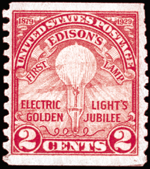 Thomas A. Edison’s light bulb of 1879 is featured in this 50th anniversary commemorative U.S. postage stamp from 1929. It first went on sale at Menlo Park, N.J., home of Edison’s lab and workshop. After 13 months of trying different materials for the filament, Edison carbonized some simple cotton thread — and turned the world on to electricity.
Thomas A. Edison’s light bulb of 1879 is featured in this 50th anniversary commemorative U.S. postage stamp from 1929. It first went on sale at Menlo Park, N.J., home of Edison’s lab and workshop. After 13 months of trying different materials for the filament, Edison carbonized some simple cotton thread — and turned the world on to electricity.
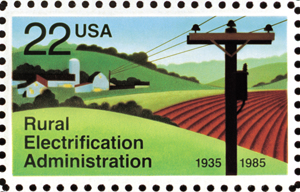 The Rural Electrification Administration’s 50th anniversary is celebrated on this 1985 stamp. The REA, which helped consumer-owned electric cooperatives electrify rural America, began as a federal relief agency by executive order signed by President Franklin Roosevelt on May 11, 1935.
The Rural Electrification Administration’s 50th anniversary is celebrated on this 1985 stamp. The REA, which helped consumer-owned electric cooperatives electrify rural America, began as a federal relief agency by executive order signed by President Franklin Roosevelt on May 11, 1935.
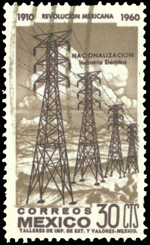 In 1960, during the 50th anniversary of the political power struggle known as the Mexican Revolution, the Mexican president found his country in another kind of power struggle. The private, foreign owners of the country’s electrical system wanted a big rate hike and, to pressure the government, threatened to stop bringing power lines to rural areas and building new generating capacity. In response, the president nationalized the country’s electric industry. The action, which proved very popular as a symbol of Mexican independence, is commemorated on this postage stamp.
In 1960, during the 50th anniversary of the political power struggle known as the Mexican Revolution, the Mexican president found his country in another kind of power struggle. The private, foreign owners of the country’s electrical system wanted a big rate hike and, to pressure the government, threatened to stop bringing power lines to rural areas and building new generating capacity. In response, the president nationalized the country’s electric industry. The action, which proved very popular as a symbol of Mexican independence, is commemorated on this postage stamp.
 Though not a postage stamp, this “Lady of the Lightbulbs” is an electric light inspection stamp used in Canada around 1900. This stamp was used on inspection reports of the electric wiring inside the house and was issued in a variety of values.
Though not a postage stamp, this “Lady of the Lightbulbs” is an electric light inspection stamp used in Canada around 1900. This stamp was used on inspection reports of the electric wiring inside the house and was issued in a variety of values.
Inventors
 Benjamin Franklin discovers the electrical nature of lightning in this 1956 U.S. stamp honoring the 250th anniversary of his birth. The stamp shows an elder Franklin assisted by allegory of youth in his famous kite experiment. Franklin and George Washington have appeared on more U.S. postage stamps than any other individuals. Franklin was featured again in a 2006 four-stamp commemorative set honoring the 300th anniversary of his birth.
Benjamin Franklin discovers the electrical nature of lightning in this 1956 U.S. stamp honoring the 250th anniversary of his birth. The stamp shows an elder Franklin assisted by allegory of youth in his famous kite experiment. Franklin and George Washington have appeared on more U.S. postage stamps than any other individuals. Franklin was featured again in a 2006 four-stamp commemorative set honoring the 300th anniversary of his birth.
 Thomas Edison appears on this 1947 postage stamp commemorating the 100th anniversary of his birth.
Thomas Edison appears on this 1947 postage stamp commemorating the 100th anniversary of his birth.
 Four famed scientists of the late 1800s and early 1900s are featured on this set from 1983. They are clockwise from top left: Charles Steinmetz, who pioneered theories of alternating current and high voltage power in the late 1800s; Edwin Armstrong, who worked with frequency modulation and invented FM radio; Philo T. Farnsworth, who invented the first TV camera; and Nikola Tesla, who, like Steinmetz, did theoretical work with AC power and invented the induction motor.
Four famed scientists of the late 1800s and early 1900s are featured on this set from 1983. They are clockwise from top left: Charles Steinmetz, who pioneered theories of alternating current and high voltage power in the late 1800s; Edwin Armstrong, who worked with frequency modulation and invented FM radio; Philo T. Farnsworth, who invented the first TV camera; and Nikola Tesla, who, like Steinmetz, did theoretical work with AC power and invented the induction motor.
Statesmen
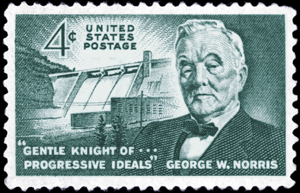 Sen. George Norris, a Republican from Nebraska, was a staunch supporter of President Franklin Roosevelt’s New Deal programs in the 1930s. He sponsored both the Tennessee Valley Authority Act of 1933 and the Rural Electrification Act of 1936 that established the REA as a full agency of the federal government. Pictured is the hydroelectric dam that bears his name in Tennessee. Norris, born and raised in Sandusky County, Ohio, has an Indiana connection: the independent idealist received his law degree from Valparaiso University in 1883. This 1961 stamp commemorates the 100th anniversary of his birth.
Sen. George Norris, a Republican from Nebraska, was a staunch supporter of President Franklin Roosevelt’s New Deal programs in the 1930s. He sponsored both the Tennessee Valley Authority Act of 1933 and the Rural Electrification Act of 1936 that established the REA as a full agency of the federal government. Pictured is the hydroelectric dam that bears his name in Tennessee. Norris, born and raised in Sandusky County, Ohio, has an Indiana connection: the independent idealist received his law degree from Valparaiso University in 1883. This 1961 stamp commemorates the 100th anniversary of his birth.
 Brien McMahon was a U.S. senator (a Democrat from Connecticut) from 1945 to until his death at age 48 in 1952. He was a major figure in the establishment of the Atomic Energy Commission through his authorship of the Atomic Energy Act of 1946 (the McMahon Act). He advocated the civilian (rather than military) control of nuclear development. This 1962 stamp was issued on the 10th anniversary of his death.
Brien McMahon was a U.S. senator (a Democrat from Connecticut) from 1945 to until his death at age 48 in 1952. He was a major figure in the establishment of the Atomic Energy Commission through his authorship of the Atomic Energy Act of 1946 (the McMahon Act). He advocated the civilian (rather than military) control of nuclear development. This 1962 stamp was issued on the 10th anniversary of his death.
Projects & Programs
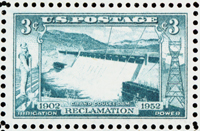 This 1952 stamp celebrates the 50th anniversary of the U.S. Reclamation Service. The agency built hydroelectric dams in the West. Completed in 1942, the Grand Coulee is still the third largest hydroelectric dam in the world. Folksinger Woody Guthrie once called the Grand Coulee, “The mightiest thing ever built by a man!”
This 1952 stamp celebrates the 50th anniversary of the U.S. Reclamation Service. The agency built hydroelectric dams in the West. Completed in 1942, the Grand Coulee is still the third largest hydroelectric dam in the world. Folksinger Woody Guthrie once called the Grand Coulee, “The mightiest thing ever built by a man!”
 This stamp was issued Sept. 30, 1935, the day the “Boulder Dam” was dedicated by President Franklin Roosevelt. An engineering marvel, the hydroelectric dam began under President Herbert Hoover in 1930 and was to be called “Hoover Dam,” a name approved by Congress. But a funny thing happened between the beginning of the project and its dedication: Hoover became much despised and was defeated in a landslide by FDR in the 1932 presidential race as the country slogged through the Great Depression. Folks within the Roosevelt administration quickly started referring to the dam by the name of the project that was building it (Boulder was the original location for the dam before a better location was picked, but the “Boulder” name stuck). In 1947, the dam’s official name of “Hoover” was restored by Congress.
This stamp was issued Sept. 30, 1935, the day the “Boulder Dam” was dedicated by President Franklin Roosevelt. An engineering marvel, the hydroelectric dam began under President Herbert Hoover in 1930 and was to be called “Hoover Dam,” a name approved by Congress. But a funny thing happened between the beginning of the project and its dedication: Hoover became much despised and was defeated in a landslide by FDR in the 1932 presidential race as the country slogged through the Great Depression. Folks within the Roosevelt administration quickly started referring to the dam by the name of the project that was building it (Boulder was the original location for the dam before a better location was picked, but the “Boulder” name stuck). In 1947, the dam’s official name of “Hoover” was restored by Congress.
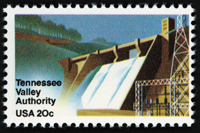 This 1983 stamp celebrates the 50th anniversary of the Tennessee Valley Authority which provides electricity to electric cooperatives in Tennessee, Kentucky and Alabama.
This 1983 stamp celebrates the 50th anniversary of the Tennessee Valley Authority which provides electricity to electric cooperatives in Tennessee, Kentucky and Alabama.
Energy Conservation & Development
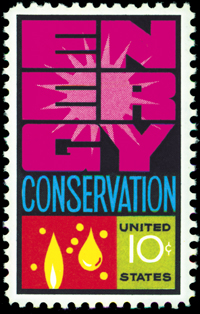 The 1970s ushered in a new era of energy conservation. The stamp at right is from 1974, issued just after the first energy crisis of that decade. The text of the 1974 USPS commemorative set noted, “Until the national goal of self-sufficiency in energy is realized, the message of the stamp will be valid. All Americans must cooperate to conserve all forms of energy.” Those words still ring true.
The 1970s ushered in a new era of energy conservation. The stamp at right is from 1974, issued just after the first energy crisis of that decade. The text of the 1974 USPS commemorative set noted, “Until the national goal of self-sufficiency in energy is realized, the message of the stamp will be valid. All Americans must cooperate to conserve all forms of energy.” Those words still ring true.
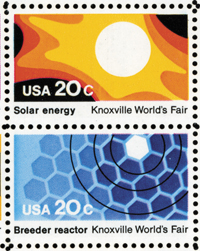 To celebrate the 1982 World’s Fair in Knoxville, Tenn., themed “Energy Turns the World,” the USPS released a four-stamp set. The other two promoted synthetic fuels and fossil fuels.
To celebrate the 1982 World’s Fair in Knoxville, Tenn., themed “Energy Turns the World,” the USPS released a four-stamp set. The other two promoted synthetic fuels and fossil fuels.
 The energy crisis was revisited in 1977 with a pair of almost identical stamps promoting “energy conservation” and “energy development.”
The energy crisis was revisited in 1977 with a pair of almost identical stamps promoting “energy conservation” and “energy development.”



